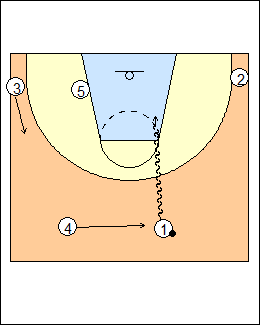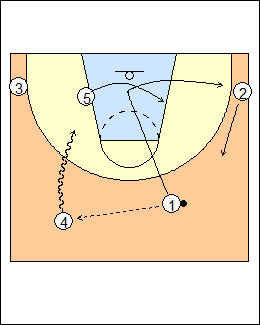Dribble-drive basics
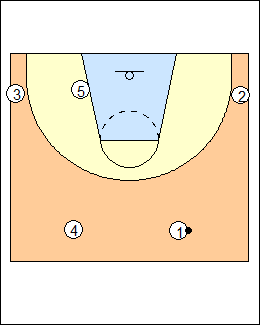 | 1 Keys Dribble penetration - Kickup Dribble-drive motion, get to the rim for layups, spacing and opening gaps are important. Key differences from conventional motion: - 5 rim runs and goes weakside (open post), then stays opposite the ball on dribble penetration (clean up or relocate), allowing backdoor cuts from the corners - rotate behind drives, attack downhill - on a perimeter pass from a guard spot, the passer usually cuts to the other side of the floor. Space the floor so the ballhandler has an open lane to the basket, move on penetration to create passing angles and make it hard for off-ball defenders to help and recover. If a driver gets stopped, pass to a teammate then it's their turn. On a catch, shoot, or drive if you aren't a shooter, or pass and cut, or pass and flatten to the corner. Mads Olesen - designate 4 to inbounds or let 1 and 4 decide on a play-by-play basis. 1 can use one blow-out dribble, 2 and 3 go no deeper than the top of the 3-point line extended when the ball is in the backcourt. If 1 attacks up the middle, 4 spaces almost to the left sideline, his angle on a kickback is really good. See Fast breaks - Two side (Rocket) - 4 runs to the weakside 45 (creating a double gap for 1). John Calipari - any player can try to beat their man, but not every player can do it, some are passers and cutters, some are shooters who look to drive if they are crowded. Jerry Petitgoue - 5 is always opposite the ball. Andrew Grantz - 5 can post for a 1-count then has to get opposite the ball. George Karl - gaps offence - if you want to play fast, spacing is the first priority. Wings sprint to corners, a big runs to the rim then gets out of the way, get him underneath the defence. Del Harris - 5 should rim run on the weakside for a better passing angle. If he gets to the ballside block and 2 stops on the wing, the only options 1 has are swing the ball or a transition ballscreen. First-side action must be clear-cut, otherwise swing the ball and look to attack. Kevin Eastman - the best position to score is on the weakside, e.g. ready to post across, or a shooter whose defender is drawn in. See Dribble-drive Outline, Progression, Walberg, Calipari, Kentucky, Petitgoue, Bollant, Nets, Oakland., also Quick hitters - Dribble-drive 243-143, X-cut, S-gap, Pin-down, Drop 5, Trail post.  |
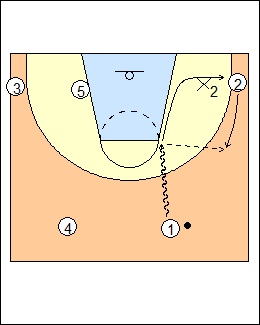 | 1) Dribble penetration a) Kickup 1 drives the elbow area (drop zone) and jump (or stride) stops, 5 cleans up, 2 kicks up for a pass, 1 loops to the corner. 2 is patient, and runs the kickup only if X2 takes away a backcut. Options - weakside 3 drags up as 1 drives, then goes back to the corner - 5 can duck in or come up to the weakside elbow (see Backdoor cut). Mads Olesen - go backdoor if your defender is between you and the ball, or if in doubt, or on a pass fake, or on a dribble-at. The backdoor will often be open if the defence is playing the corners high to take away drives; if low and flat, the kickup will be more available. The kickup is among the last things he would teach. If 1 gets pushed out of the drop zone, you can still run all the options with a dribble hand-off. Olesen - if 3 sets up low in the corner, he starts dragging up as soon as 1 drives away from him, looking for a pass from the drag zone, then goes back down if penetration stops early, in the drop zone. |
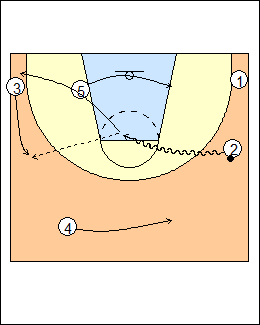 | If 2 drives middle, 5 relocates, 4 kicks back, 3 kicks up for a pass (or backcuts or stays in the corner), 2 exits cuts and replaces 3. 3 can move when 2 crosses the lane line, or when 2 gets to the middle, or when 2 stops. X4 can stop the ball or stay with 4, but can't help and recover. Olesen - 3 will stay in his corner then look for drop-zone options on any stop. If 2 doesn't attack, 4 can move over looking for a pass. Harris - if the ball is dribbled toward you on the perimeter, move toward the ballhandler instead of drifting (break a 3-in-a-row). 5 can move out to the baseline on the weakside or cross under to the other block, which Harris prefers. |
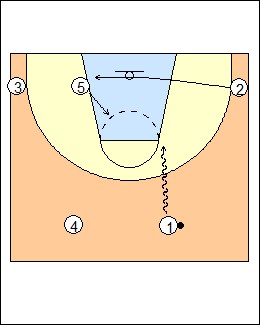 | b) Backdoor cut 1 drives, stops in the drop zone, 2 backcuts if overplayed (and keeps going), 5 ducks in (shown) or comes up to the weakside elbow, 1 can pass to 2 or 5. Optionally 3 drags up for a skip pass and 4 can come off 1 for a handoff. Olesen - from the corner, 3 drags up then goes back. For a backdoor, it's better for 1 to higher in the drop zone than the elbow. As 1 stops in the drop zone, 5 takes one step up the lane getting ready to clear out if 2 backcuts. The cue to 2 taking off is X2 turning his head towards the driver. 5 steps hard high if 2 does not get a pass. If 1 can't hit 2 or 5, have 4 run outside around 1 (a kickdown cut). Karl - work on transition defence because shooters are in corners and the ball is going to the rim. |
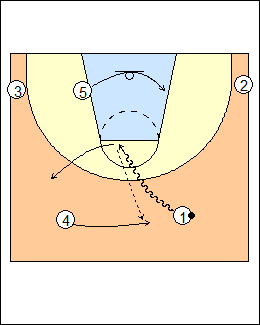 | d) Kickback On a middle drive by 1, 4 rotates behind (kicks back), 5 relocates, 3 reads whether to backcut, kick up, or stay in the corner. The kickback is behind 1 (a positive pass), so 4 can catch and attack downhill (then 2 is patient in the ballside corner). Olesen - use positive passes on kickbacks and kickups, the receiver has a clear path to the basket, and switching defences are punished. When defences switch or sag, hesitate and shot fake to make a defender close out, don't go full speed all the time. Be patient against teams that sag, use repeated cuts, passes and penetration. Harris - second penetration often creates something more positive than the first. 4 is in good position for defensive balance if 1 shoots or dishes off inside. |
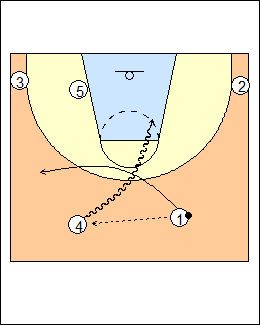 | 2) Playing in the gap To create a larger driving gap for the ballhandler, pass and cut from a guard spot, usually to the other side of the floor. Grantz - on a perimeter pass, basket cut looking to score then fill out opposite where you started. Calipari - when the ball moves on the perimeter, we're not shooting a 3, we're driving the ball. Marc Hart - Tips to improve DDM - pass through single gaps, drive through double and triple gaps. Start your offence as much as possible with a one-guard front. To create a triple gap for 3, see Quick hitters - Dribble-drive 243-143. a) Loop cut |
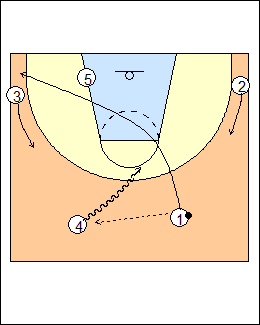 | b) Corner cut For a bigger gap, 1 cuts all the way to the ballside corner, especially against switching defence. Calipari - to create a big gap for 4, 1 passes and cuts all the way to the corner, 4 drives off his butt (2 comes out when 4 gets to the middle). More often, 1 will cut hard to the nail (nail cut), allowing 4 to drive right or left. Kentucky - go through the elbow then out the other side (to the corner).  |
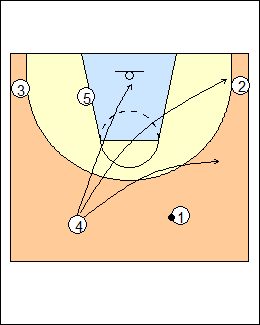 | d) To create a gap for 1 (or on denial), 4 cuts with no pass. Walberg - 1 wants 4 to cut through, giving 1 the whole court up top, now he can make counter dribbles (secondary moves). 4 cuts to score, stops under the basket, reads where 1 goes, and comes out opposite. Dave Smart - the Ravens dive the post matchup and the worst shooter. Olesen - dribble-drive is not meant to be played with a two-guard front. 4 backdoor cuts hard to the basket if denied. He must step high, call for the ball, then cut hard to the basket (towards the middle of the key, not straight down the lane, 5 would be in the way). 1 can initiate a through cut by 4 with a step-back dribble. Bollant - 4 can rub cut (loop under 1). Kentucky - pullback (and quick-replace) - a pull-back dribble by 1 tells 4 to go, they like a corner cut because it gives a double gap, they don't rub cut because teams switch it. Karl - get out of the way of the ball and let it attack, attack double gaps off the dribble every time. Know what you are going to do before you catch it, go-catch, move toward the basket before you receive the ball, don't catch and then go (San Antonio has a one second rule - you can't have the ball for more than one second). Hart - if a guard-to-guard pass is not open, 4 gets high and wide or cuts through to create a triple gap. |
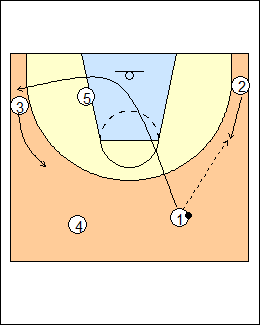 | e) Quick On a pass to a wing ("quick"), basket cut and clear weakside (like motion offence). 2 blast cuts and can drive middle or baseline. Quick-fist ballscreen - 5 picks and rolls with 2. Walberg - 4 gives 2 a two-count before moving over (fill late). Kentucky - the passer reads the ballhandler on a Swing or Quick set. In the flow of the offence, "quick" can also be set up by a kickback (see Calipari - Second drives). Olesen - 2 must v-cut to get open if he can't just go get the ball. 1 should start his cut while the pass is in the air, 2 shouldn't be able to make a move before 1 cuts. With a dominant post player, it's a good idea to have 1 set a screen for 5. Bollant - Quick - against teams that force baseline (keeping the ball out of the middle), 1 jump stops (in the drop zone), passes to 2 and cuts through, 2 can drive baseline right away, or drive middle, crossover and go baseline. Lisa Thomaidis - on a wing-to-guard pass, the wing slides away to space. Penetrate-pass-pass - teams can usually cover the first pass out of penetration, the second is a long close-out. Penetrate-penetrate is a turnover in practice, you're going back into defence that collapsed. Randy Sherman - quad offence - on a diagonal pass (slot to wing), make a diagonal cut directly to the opposite corner; basket cut on a horizontal guard-to-guard pass. Olesen - quick replace - if 1 starts to cut then replaces himself and gets a return pass, 4 cuts to the basket and 2 drops to the corner, creating space for 1 (the same action as a step-back dribble). |
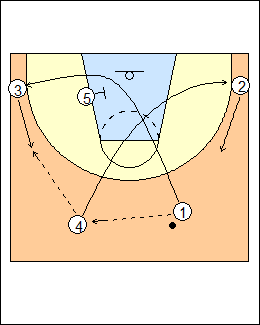 | f) Swing-quick 1 passes to 4 (swing) and basket cuts (or corner cuts), 4 passes to 3, basket cuts and clears weakside (quick), 1 exit cuts to the ballside corner for floor balance. 3 can drive (the middle is open), make a post feed, or pass to 1 in the corner and basket cut, 1 looks to pass into the post or attack middle (or 5 can ballscreen). The 1-3-5 triangle can be used to get the ball into the post. Olesen - if 5 is dominant and 4 swings the ball, 1 must recognize this and exit weakside on a through cut, anticipating a post pass (4 holds). The first rule to get the ball to a great post player is the middle rule, when 1 passes to 4 (across the middle of the court) he does not cut, 3 comes up for a catch and post entry. See Walberg post-up, Bollant 1-4-3 passing. Calipari - to create a lane for 3, 1 passes to 4 and holds, 4 passes to 3 and basket cuts, 5 relocates. Butler ballscreen - 5 picks and rolls with 3. Dave Clarke - motion away - 4 screens across for 2, see YouTube video Ballscreen dribble-drive. Harris - if the ball is passed into the low post in a wing-corner triangle, the corner must cut hard baseline, the wing stays ballside unless he screens away at the top for another player. |
